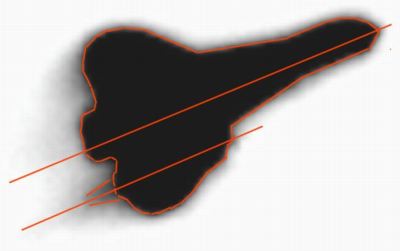We are developing the social individualist meta-context for the future. From the very serious to the extremely frivolous... lets see what is on the mind of the Samizdata people.
Samizdata, derived from Samizdat /n. - a system of clandestine publication of banned literature in the USSR [Russ.,= self-publishing house]
|
For those who feel like a little (slightly horrifying, but not especially surprising) insight into the French way of doing business, might I recommend reading this article from the Economist giving a detailed history of the various occasions in which Airbus Industrie have been revealed or alleged to have paid kickbacks in order to procure orders for their airliners. It is worth observing that to some extent the cause of the problem is the traditional structure of the airline industry, in which there have been a great many state owned carriers for which aircraft purchases have had to be approved by (very corruptible) government (or in some instances even military) officials. Airbus are by no means the first company to indulge in this sort of activity, but the enthusiasm with which they apparently have gone about it, and the apparent collusion and encouragement of the French government, are quite impressive.
A highlight
The Delhi court has a withering opinion of the help Airbus has given the CBI. It allowed Mr Wadehra to add Airbus’s Indian subsidiary to his action on the grounds that Airbus in France was not co-operating. Airbus told Mr Wadehra that French law forbade it from answering his questions. “[Airbus] sells its aircraft on their merits,” the firm insisted.
The court has castigated the CBI for its dilatory approach. It took the Indian authorities until 1995 to contact Airbus for information, only to be told that such requests should be routed through the French government. The CBI told Mr Wadehra, despite trying Interpol and diplomatic channels, it was not getting any help from the French government. The French embassy in Delhi in effect told Mr Wadehra to get lost when he wrote to ask why France was not co-operating.
(Link via Arts & Letters Daily).
Sometimes things cross my desk which are so interesting I have to just pass them on verbatim. I’ve been expecting this one for years. In 1999 I walked under the wings of the Proteus high altitude aircraft in the Rutan hanger at Mojave. I knew immediately that Rutan had to be thinking of this as a first stage prototype. I also knew that I would not hear about such a thing until roll out.
Rollout day has finally arrived.
Here is a press release from Huntsville L5.
Huntsville Rocket Man Key Player in First Private Manned Space Program
Legacy Ties to Local HAL5 HALO Program
In the early morning hours of April 18, before the in burning heat blasted the Mojave Desert, the hangar doors swing open to reveal yet another strange craft with the obvious signature of the designer. Burt Rutan, President of Scaled Composites LLC, thus unveiled “The First Private Manned Space Program” with the roll-out of the suborbital SpaceShipOne. SpaceShipOne will be air-launched from the “White Knight” high-altitude research aircraft at 50,000 feet. Once released, SpaceShipOne will fire its rocket engine and climb to over 100 km (62 miles), carrying a crew of three into space on a suborbital flight. The rocket engine that will enable this historic feat was co-developed by Huntsville-native Timothy L. Pickens, who served as the Propulsion Systems Developer for Scaled Composites.
Tim first met Burt Rutan (designer of the famous Voyager aircraft) at an AIAA event in Huntsville in 1998. Because of their common interests, a professional rapport developed that would lead to Burt asking Tim to move to Mojave and lead a very important part of this “history in the making.” From what started out as napkin sketches with Burt in a Huntsville restaurant became what was rolled out in the Mojave. The propulsion concept was very much rooted in the Rocket City. Tim’s contributions to the SpaceShipOne project drew extensively from his involvement in HAL5’s High Altitude Lift-Off (HALO) Program. HALO pioneered the high-altitude launch of hybrid rockets.
Tim’s SpaceShipOne responsibilities included main and RCS propulsion development, nitrous-oxide portable fill station, rocket motor test stand, ECS support, propulsion fluids, and pressurization. Two hybrid motor vendors were selected to handle the fuel pouring, injector/valve design, and engine controller. This allowed Tim to reduce Scaled’s workload, decrease costs, and focus on the complex issues of designing the hybrid rocket motor, fuel case, and nozzle.
SpaceShipOne’s hybrid rocket engine employs a solid fuel grain (HTPB rubber) and a liquid oxidizer (nitrous-oxide), providing greater safety and lower cost than fully solid or liquid rocket engines. Scaled’s hybrid motor also employs a common bulkhead between the oxidizer tank and the motor. Tim’s co-designed the case/throat/nozzle (CTN) which reduced weight and complexity. This approach saves weight and reduces complexity. SpaceShipOne will be the first venture to launch people into space without government money or government technology. Rutan claims this will be accomplished before the 100th anniversary of the first powered flight at Kitty Hawk (17 December 2003).
SpaceShipOne’s Huntsville roots can be seen in HAL5’s Project HALO. HALO’s hybrid rockets utilize either an asphalt or HTPB solid fuel grain with liquid nitrous-oxide that is kept in an oxidizer tank separated by a common bulkhead with the motor case. In 1997, HALO air-launched a hybrid rocket from a high-altitude balloon over the Atlantic Ocean into the edge of space. That HALO mission, designated Sky-Launch 1 (SL-1), is listed in the Guinness Book of World Records 2000 (Millennium Edition) as the highest flight of an amateur rocket (36 nautical miles).
Like SpaceShipOne, HALO SL-1 used no government money, nor hardware. HAL5 had tested a rocket utilizing the same motor design a year before when it launched HALO Ground Launch-1 (GL-1) from a field in Tennessee to about 30,000 feet. In 1998, the group conducted the HALO SL-2 mission from a barge in the Gulf of Mexico. Other projects that spun off from HALO included the Balloon Launched Return Vehicle (1998) and the Cheap Access to Space (CATS) prize launch (2000). The HALO Program began in 1994 with a high-altitude balloon flight, launched from Huntsville’s Space & Rocket Center Alabama. Rocket motor testing at a site just east of Maysville in rural Madison County began early in 1995, followed by dozens of high-altitude balloon flights and hundreds of rocket motor firings. Tim Pickens was the Rocket Lead/System Designer for all of those local HALO and HALO spin-off projects. He was responsible for all mechanical and system designs.
Tim has returned to Huntsville where he continues to support Rutan’s propulsion efforts on a consultant basis. He is currently a propulsion engineer working for Plasma Processes and runs his own propulsion test company called Orion Propulsion located in Gurley, Alabama. Tim has designed and built a rocket-powered bike featured in Custom Bike magazine, and he is currently working on a “James Bond” type rocket belt. Mr. Pickens, who began his serious hybrid rocket work with the HALO Program, has since worked on such noted rocket engines as the RL-10, Fast-Track, the Space Shuttle Main Engines (SSME), and Space America’s 4000-50,000 pound thrust LOX/Kerosene engines. HALO member Glen May currently works for Scaled Composites in Mojave, California as a propulsion technician responsible for many aspects of the program.
Tim and other members of Project HALO will be testing future rocket engines and are available for press interviews on Thursday, 24 April from 7-10 PM, at his rocket workshop located at 104 Lindell Drive in Madison. For more information on Project HALO, please see web site.
HAL5 will host a public presentation by Mr. Pickens on the Huntsville connection to SpaceShipOne at the Huntsville-Madison County Public Library main auditorium on Thursday, 1 May 2003 from 7:00 to 8:30 PM. The public is invited and attendance is free. For more information, please call (256) 971-2020.
HAL5 is the Huntsville Alabama chapter of the National Space Society. It formed in 1983 as a non-profit, 501(c)(3), space educational/advocacy organization. Members share the enthusiasm that space development can stimulate our world with immeasurable benefits in the areas of education, energy, environment, industry, resources, and (ultimately) room to grow for our society. Members believe that by educating and working with the public, the government, and private industry, we can speed up the date when routine, safe, and affordable space travel is available to anyone who wants to go. Tim is helping this to become a reality.
The National Space Society, formed in 1974 by Wernher von Braun, is an independent, non-profit space advocacy organization headquartered in Washington, D.C. Its 23,000 members and over 50 chapters around the world actively promote a spacefaring civilization.
Please note that the NSS was created from the merger of two organizations formed around the same time; Werner Von Braun’s NSI mentioned above, and The L5 Society from which myself and chapters such as Huntsville L5 came from. The two merged in 1987.
Greg Allison, the leader of the HAL5 group is usually seen wandering about the yearly ISDC
The National Space Society invites you to join fellow space enthusiasts at the International Space Development Conference, May 23-26, 2003, in San Jose, California. Buzz Aldrin will be hosting a tour of the U.S.S. Hornet on Wednesday, May 21. For more information, visit the conference website.
I’ll be there: I hope I’ll see you too!
Last night the British television channel, Channel 4, gave us another superb documentary history programme with a great twist – the story of the Dambuster raid on the German dams in WW2. It relayed the story of how Wing Cmdr Guy Gibson (a mere 24 years old) led a squadron of Avro Lancasters to smash two dams using the famous “bouncing bomb”.
The programme makers got a group of present-day serving RAF aircrew, including two women, who work in the very different airforce of today, to try to repeat the feat of Guy Gibson’s men, using a flight simulator and a real-live Lancaster. These modern flyers are used to state-of-the-art navigation technology rather than the old pencil, map and compass techniques that had to be used back in the 1940s, when radar-based techniques were in their relative infancy.
It made for compulsive viewing. And one thought stuck in my head. Most of the flyers are about on average 10 years younger than me (I am 36). Gibson, as noted above, was just 24. I don’t think – as the Iraq campaign demonstrates – that the best of our young folk today are any less capable of performing heroic and dangerous feats than our forbears. And while I would prefer to see such talents used for peaceful purposes like entrepreneurship rather than flying a bomber, I think recent events bode rather well for our future.
That’s something to remember when London gets infested with the usual rag-bag of anti-globalistas and Saddam mourners on May 1.
So, just three things here so far today, one very short and two rather serious. So here are a couple of curiosities.
First, there is this map, which was originally claimed to have been taken posthumously by Columbia before it burned and crashed. You want this to be true, don’t you? As did Michael Jennings. But as I commented at Michael’s, those killjoys at snopes.com have now killed this particular joy. But it is still a thing of beauty, and certainly has my little country looking its best. Snopes says it is “false”, but their map is even bigger than the one Michael put up, so they liked it even as they trashed it.
And the other is a beating heart, courtesy of b3ta.com. Who are those guys?
When you consider all the metaphorical baggage that has been loaded onto the human heart over the centuries, it turns out to be very small and yucky, and you can swap yours for another with “you” carrying on pretty much as usual. It’s just a pump.
And a picture is just a picture.
It appears that we may have underestimated the soaring ambitions of the European Union. Not content with absorbing the ‘Vilnius 10’, they have set their sights on outer space:
“Europe’s first mission to the Moon looks set for a July blast-off.
Scientists and engineers working on the Smart 1 spacecraft are hoping to fly around the 15th of that month – but it all depends on the status of the launcher.”
Doubtless this will be the first of many such missions designed to extend the scope of the European orbit. According to French EU Commissioner Bertrand Maginot:
“At this time, the cosmos is totally unregulated. This is an intolerable situation.”
A Swedish EU representative, Helena Hankårt was prepared to outline the precise aproach:
“It is not so much that we intend to conquer space. It is more a question of bringing space within democratic control.”
The British deputy chair of the Celestial Expansion Committee, Sir Crispin D’oilly-Gitte was rather more forthright in his views:
“Oh but we simply must extend Euwopean influence into space. Otherwise it will be full of those fwightful Amewicans”
The Celestial Expansion Committee has drawn up detailed plans for future ventures and even a broad agreement on contingency operations, as indicated by Dutch Committee member Willy Van Der Pimp:
“There is a draft plan setting out an appropriate response in case of encounters with alien life-forms. However, it is agreed that the aliens must commit themselves to meeting certain minimum regulatory standards before any communication can be approved.”
Members of the committee refused to be drawn on the question of whether space should, indeed, be referred to as the ‘final frontier’.
I have not been posting on this subject for awhile as there has not been any single bit of news significant enough to require it. The weight of the bits and pieces has finally built to the point at which I must return to it.
Little has changed in the basic scenario of the breakup. Most everything I have read has added detail or backed up early scenarios. One of the more interesting bits was the set of internal emails released by NASA. As an engineer myself, I know this sort of “what-if” goes on all the time. In any given team at any given time there will be persons who are overly optimistic or pessimistic. Everyone takes a turn in these roles; everyone has a day of certitude on some new hypothesis. The problem a manager faces is how to figure out whether that person is actually correct on some particular day and some particular issue. Usually the answer is in the middle ground. When it isn’t, you’ve just bet your career,
In this case the pessimist wasn’t pessimistic enough. He was worried about a portside gear door burn through causing a failure of that gear to descend on landing. An aircraft with one gear down is in deep shit. A friend of mine managed to get he and his wife safely on the ground in a Cessna 180 with that problem… but none of the techniques he used would work on a brick that doesn’t so much land as carry out a controlled 220 mph near-crash. Believe me, you really, really do not want to ground loop at those kinds of speeds. I’m sure anyone else out there who has ever landed an airplane by their sweet lonesome would get the same retractive reflex I get at the thought.
The point is, things were far worse than the most polyannish engineers thought.
Some of the other interesting news is confirmation bits were coming off even before the shuttle crossed the Pacific coast. This validates the report we noted from a San Francisco paper, and the first hand report of one of our friends at XCOR in the Mojave Desert. A shuttle tile has been recovered from Nevada. They are searching for more in the area as it is those earliest bits of debris which will tell the greatest tale.
The USAF has a lot more detail on the radar reflection from near the shuttle on Day 1. Something 1×1.3 feet in size was floating near the shuttle shortly after a “major maneuver”. I’ll guess that means a brief blip on the OMS system. If something were loose, that is exactly when you’d expect a seperation.
No one knows what it was. The size and orbital characteristics coupled with the time it appeared suggest to me it is not from a waste water dump and not due to an orbital debris impact. We’re left with either something floating out of the payload bay or something broken during the ascent. Its’ rapid de-orbiting tells us it had a low mass to area ratio. That certainly isn’t true of water at 60 pounds per cubic foot. I cannot tell you much else though. Virtually anything structural on the shuttles is quite light.
I read this as evidence of quite severe damage caused by the foam/ice impact we’ve all seen in slo-mo by this time.
The news I found rather amazing is the recovery of video tape that was in the cabin. Some was burned: I am utterly amazed that it wasn’t all fried, or at the very least heated above it’s Curie point and completely demagnetized. This is a sad experiment to have the results of, but I must admit the details are fascinating and not at all what I had expected. Other than the larger debris footprint, the results are little different from an airliner crash. Some bits are amazingly intact through sheer providence… and nearby parts ravaged beyond belief.
It seems clear another of my early predictions is correct as well. They are never going to find more than a fraction of the vehicle. Tangled bits will be showing up for centuries. Farmers will be plowing them up and selling them to museums and collectors 500 years from now. It may even be centuries, or at least many decades before the last of the major parts turns up.
Columbia is now an eternal part of the Texas landscape and history.
Taking my life into my hands the other day, I squeezed around the London Underground and found myself pressed up against an advertisement on the Piccadilly Line for that manufacturer of jobs, I meant ‘first-rate military equipment’ British Aerospace or BAe as it would now prefer to be known.
I discovered that Royal Air Force pilots enjoy the delights of an ‘assertive’ and ‘calm’ woman’s voice, produced by electronic circuitry, telling them ‘Missile locked onto you’, ‘Pull up! Pull up’ and ‘You fool! You’re going to die’… I made that last one up, I hope.
The advertisement informed me that the pilots affectionately know this disembodied squawking harpy as ‘Nagging Nora’. Far be it from me to even hint that this nickname could be anything other than a cute moniker of endearment. However, the only person I have met in the last five years who worked in the R.A.F. was a woman, although she wasn’t a pilot. And I also know that gays are now allowed into the armed services. So this caused me to wonder… Has a pilot been sued for divorce yet, by a jealous wife, angry at her beloved calling out of ‘Nora, Nora’ in his sleep?
Can a female pilot sue the R.A.F. for refusing to provide her with a ‘Nagging Norman’ voice, perhaps modelled on the authoritarian tones of that former pilot Lord Tebbitt? Can a homosexual pilot demand the same (which would be funny given Lord Tebbitt’s known ‘enthusiasm’ for gay rights)? And if different voices are provided for women and gays, will it be considered ‘pressure’ on lesbians to reveal their sexuality to admit that actually, they rather preferred Nagging Nora’s soft and assertive tones, all along?
As we prepare for war, I hope that these vital issues for the nation’s defence are given the proper attention that they deserve. And never mind that the Tornado is hopelessly outclassed as a fighter by the Iraqi Mig 29s.
Kudos to Steve “SteKwack” and his friend for passing these enhanced images along to me. In Steve’s words:
“I saw your weblog entry relating to the shuttle damage, and saw a long range photo which I suspect was taken by one of these targetting systems. A buddy cleaned up the picture and vectorised it. The pictures clearly show some form of plasma streaming off the left wing, along with what may be turbulence caused by damage on the front of the same wing.”
Now let’s see what he is talking about. First we have a “solarized image”.

We are seeing the shuttle from below, so the wing at the bottom is the port (left) side where the problems occurred. The double delta wing plan shows up clearly on both sides of the fat and blunt-ish fuselage; the squared off thing at the stern is the body attached elevator which sits directly underneath the SSME’s (Space Shuttle Main Engines). The OMS pods may be the cause of the apparent rounding of the elevator; the tail is either hidden in this view or too thin to show at this resolution.
What leaps out at you is the double bump at the boundary between the two parts of the double delta. Given the level of detail I see elsewhere this is a huge break not only in the leading edge, but in the front wing structure itself.
The more amorphous deformation of the trailing edge is a plasma trail that should not be there and which shows only on the damaged port side.
Next we see a vectorized version of the same image:

The green line faithfully shows the fuselage center line. For control to be possible, the centers of Lift, Thrust, Drag and Mass should lie along this line. The blue vectors show a flow line through the damaged leading edge to the plasma tail coming off the trailing edge.
Finally, they put them all together:

Whether the break at the division between the two delta planforms is entirely structural or a combination of damage and turbulence, it should be apparent to anyone this spaceship is already deep into its’ final death throes. I do, in fact, expect the deep notch is plasma on either side of a structural break in the wing at that point. 2000 degree Fahrenheit plasma is most likely ripping through the wing interior from the tip of the notch. Wires are burning, aluminum frame members are weakening and total structural failure is imminent.
Note: If Steve would like credits added for himself and his friend, I’d appreciate it if he would comment and give me full names to use.
A couple of days ago I noted it is not unusual for the USAF to use the landing shuttle as a test target for their space defense optical systems. They did so this time as well and are reported to have seen major wing damage.
I’d love to see those photos, but I would say there is a fair chance it would take a security clearance to do so unless they were taken by something non-black and not even “grey”.
ANOTHER ONE: While I was not the one to first note this, I did report it early on. Insulation hits began causing tile damage after NASA switched to an “environmentally friendly” (read that as Astronaut killing) non-CFC based material.
EXTRA! Reader GK Elliot pointed me to this Craig Covault article on the story.
A few of you may have noticed a comment I made a few days ago about the flaking problem being due to NASA trying to be green. I didn’t follow up on it at the time because I had very little more than hearsay on it then. Brian Carnell has the confirmation.
We may just have to lay this disaster at the feet of the Environmental Protection Agency (EPA).
Further, I believe safety recommendations for return to flight should require a return to the old and proven CFC based ET (External Tank) insulation foam.
While I was at tea (or more accurately, pizza) after my earlier flurry of keystrokes, I received a call from Jim Bennett. Some of you know him from “Anglosphere”. I known him from his AMROC and Starstruck launch company ventures. The pizza got cold but the ideas flowing back and forth over the phone line should have been enough to reheat it.
First of all, Jim came up with one more question which needs to be dealt with.
If the engineers saw the insulation hitting the wing, couldn’t they have called for an RTLS (Return To Landing Site) or TAL (Trans Atlantic) abort? No. The material was not easily seen. It was later that it was noticed and at least two days before it was analyzed. An abort would have had to occur almost instantly. Even if we assume someone could have monitored, realized implications and reported it as it happened, we are left with a stark choice. We don’t know if it is a Category 1 problem and the shuttle has never flown an RTLS or TAL outside of a computer simulator. I won’t go into great detail on the maneuvers required. Lets just say they are “interesting”.
As we talked, it struck me there was a possible scenario if a shuttle could be gotten up quickly. Those old rescue balls must surely be in storage somewhere. A second shuttle with a skeleton rescue crew could send one man across to stuff the plastic balls in the outer airlock. Then they could cycle the crew through one at a time and have them carted across. I still had strong doubts a shuttle could be programmed for the weight and balance and particulars of the rendezvous in less than 6 weeks unless NASA took serious risks. (If there is anyone at KSC or HMSFC out there willing to put a hand up, please correct me). Then Jim came up with the idea. Some of the new commercial ELV’s are more easily programmable. All you really need to get up there is probably O2 for breathing and CO2 scrubber cartridges. You could perhaps get some food and water as well, but I don’t believe they are as limiting.
I can only see one problem here. The Canadarm was not installed and there is not (to my knowledge) any sort of portable maneuvering unit on board a flight that only has an EVA suit for the contingency of payload bay doors not closing properly. So the one astronaut in the one EVA suit is going to have to bet his life on a jumping for it. If he hasn’t enough tether, he’ll have to free jump. That’s an all or nothing, life or death bet.
Then they have to survive.
The shuttle is in a low orbit, it would probably re-enter in much less than 6 weeks unless measures were taken to reboost. They could do a small OMS burn since their goal is not re-entry. They might even have enough margin to do it without cutting into the fuel for re-entry.
Then they power every thing down; sit as quietly as they can; talk to friends and relatives on the ground and try to stay alive for 6 weeks or more. It would be simply awful, and I imagine the – how to put this delicately – “scent” would be somewhat like a sewage treatment plant in the summer sun. But they might be able to last.
Then bring the crew across in a combination of rescue balls and EVA suits. If a repair kit can be put together, the damage could be assessed and perhaps repaired. If it cannot, the shuttle can be set on autopilot to do a controlled self destruct re-entry; if repair is possible, a two person crew of pilot and commander could take the risk of bringing it back.
If all of this seems to be moving in the direction of large numbers of dice rolls falling your way… you are absolutely right. There are so many potential problems with the re-supply and rescue I’ve not even bothered listing them. But if there were no other way and we were sure of the consequences of the re-entry, I’m sure drastic measures would have seemed more reasonable than watching seven people die.
NOTE: Many thanks to Jim Bennett for the brainstorm upon which this post is based.
By the way: Here is Jim’s column about the shuttle and its’ replacements in National Review.
|
Who Are We? The Samizdata people are a bunch of sinister and heavily armed globalist illuminati who seek to infect the entire world with the values of personal liberty and several property. Amongst our many crimes is a sense of humour and the intermittent use of British spelling.
We are also a varied group made up of social individualists, classical liberals, whigs, libertarians, extropians, futurists, ‘Porcupines’, Karl Popper fetishists, recovering neo-conservatives, crazed Ayn Rand worshipers, over-caffeinated Virginia Postrel devotees, witty Frédéric Bastiat wannabes, cypherpunks, minarchists, kritarchists and wild-eyed anarcho-capitalists from Britain, North America, Australia and Europe.
|






